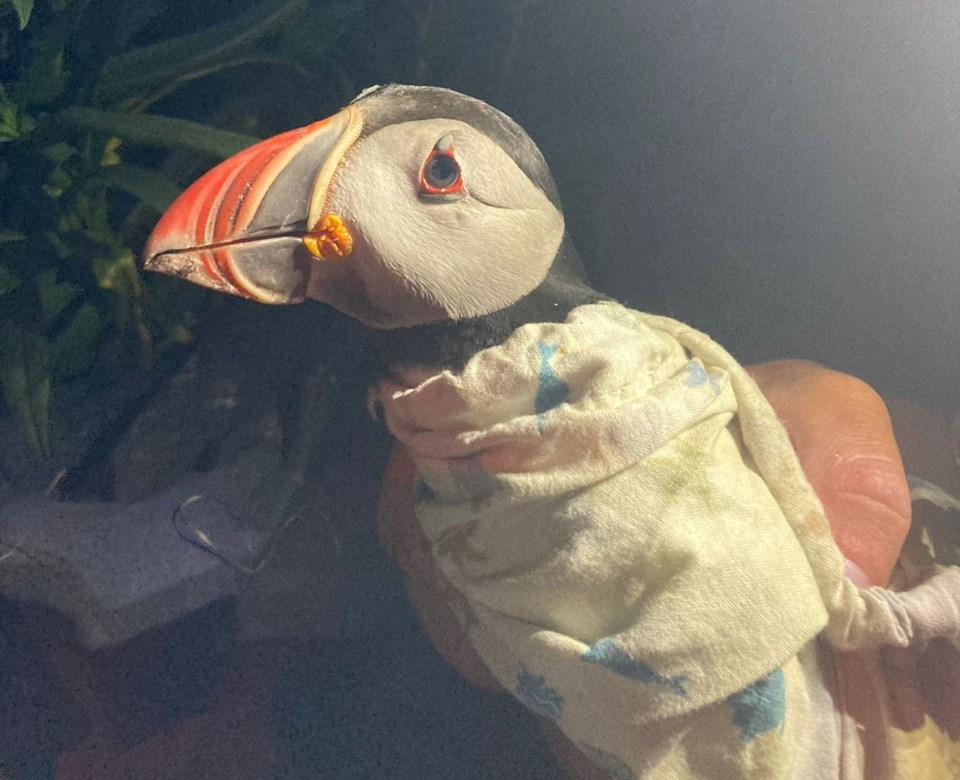FREDERICTON — Daniel Oliker held a 33-year-old puffin from Machias Seal Island in his hands and was in awe about how it was a decade older than him. It felt like he was holding a world of knowledge and history in that puff ball of black and white feathers.
The University of New Brunswick graduate student, researching Atlantic puffin ecology, found a bird with a plastic band dating back to 1992. It showed the tuxedo bird to be a wise and worldly 33. And it had a chick.
Machias Seal Island is a flat, treeless sanctuary for seabirds located about 19 kilometres southwest of New Brunswick's Grand Manan Island at the mouth of the Bay of Fundy. It has about 8,600 breeding pairs of puffins.
Oliker said last week his fellow researcher spotted one of the tuxedo birds on the island with a faded, green-and-white plastic band, and marked the area where it was seen. Those bands were used by Canada Wildlife Services starting in the 1970s until around 1995, when they started being replaced with metal ones.
Around midnight Oliker and a couple of researchers went to search the burrows — nests where puffins rest at night after a day at sea — looking for the old bird.
After searching a few burrows, he said he found the right bird by feeling the bands on their legs. A few had metal bands.
"Then I felt one that felt a little bit different, and it was in the right location that we marked so I pulled it out and it was the right guy," he said in an interview from the island.
The old bird was curious and didn't put up much of a fight when it was pulled out.
The researchers replaced the plastic band with a metal one, giving the puffin its new number: JG18. But they don't yet know its gender.
That he was holding one of the oldest birds, Oliker said, was "very exciting" and "truly amazing." Most puffins in the wild live up to their mid-20s.
"Just to think of how many years he spent out on the open ocean. How deep he's dived before. It's fascinating to think about just how much this bird has gone through, what it's seen, and the fact that it's still here and raising a chick. It speaks to its persistence."
The chick was a "decent size," which was pleasantly surprising because puffins are struggling this year from a seeming lack of food, he said. There have been a number of eggs that haven't hatched and several pufflings — babies — have died, he added.
"It is very probable that this puffin, being so old, has experience and knows what it's doing. So it's been able to find a good burrow for its mate, himself and the egg, and then able to produce a chick," he said. "It's very likely, because he's been alive for so long, that he knows which spots might be better for fish."
Puffins start reproducing around four or five so JG18 has probably had more than 25 chicks in its lifetime even if all didn't survive, Oliker said.
Nick Lund, a network manager for U.S. wildlife conservation organization Maine Audubon, said one of the biggest threats facing Atlantic puffins in the Gulf of Maine is climate change.
"The Gulf of Maine is the southernmost breeding area for puffins in the Atlantic, but the water is warming very quickly," he noted.
"New fish species are moving in to the warming waters, and other fish species — those traditionally eaten by puffins — are moving out. Whether or not puffins can adapt to eat the new fish species is a major question mark for their continued survival in the gulf."
The International Union for Conservation of Nature lists puffins as "vulnerable," which means they face a high risk of extinction in the wild.
Finding these "very" old puffins is interesting and important because it provides data confirming longevity, said Heather Major, a marine biology professor at the University of New Brunswick, who is studying these birds on Machias Seal Island.
A paper published last year in the journal Ecology and Evolution said adult survival of puffins has declined over time, which is particularly concerning because they are an important component of population growth rate.
Puffins are a cold-adapted, northern species in this region that have been exposed to some of the warmest waters in comparison to puffins in other regions, she said.
"(The finding of JG18) is important information given recent warming in the region," she said.
Oliker said he hopes he can see the puffin for the next few years.
"We have yet to give him a name," he said.
"Now that he has a new band and we know which guy he is in the database, we can come up with a name, and maybe it'll be fun to see if he's still around the next few years. And we can call him by his name."
This report by The Canadian Press was first published July 12, 2025.
Hina Alam, The Canadian Press



